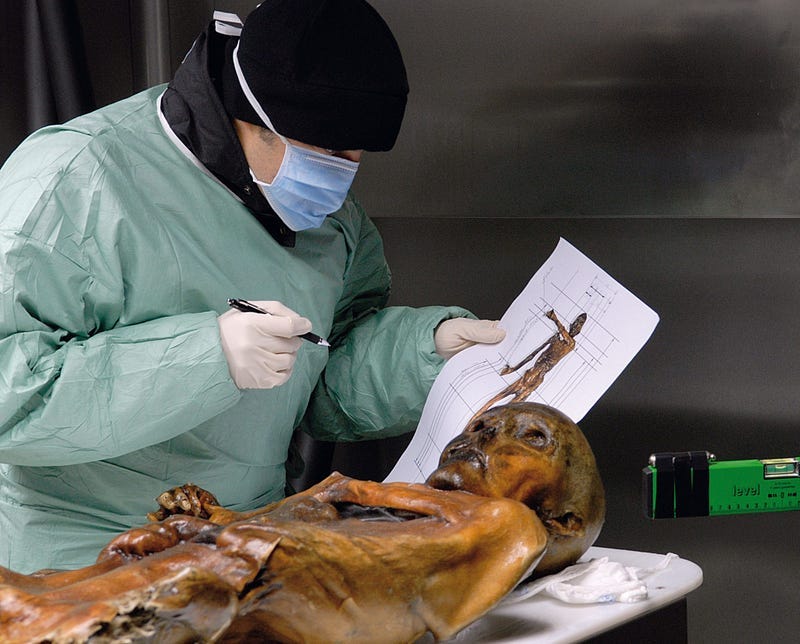Iceman Ötzi's Medical Records Are Similar to a Modern Person
Ancient humans suffered from the same diseases as us

In September 1991, two German hikers holidaying in the Alps at the Austria-Italy border discovered a shriveled frozen corpse. Erika and Helmut Simon assumed it was the body of an unfortunate mountaineer who met with an accident, and they immediately alerted the authorities.
The find intrigued forensic experts. It wasn’t a lost hiker’s body but of a man who died almost 5000 years ago. The frozen corpse came to be known as Iceman Ötzi, named after the Ötztal Alps, where he was discovered.
Ötzi lived between 3400 and 3150 BC during the Copper Age. His body was covered in over sixty tattoos.
Since the discovery, scientists have conducted detailed analyses of his body and his equipment, providing information on who he was, what he ate and wore, and the cause of his death.
His medical history caught my eye.
He had arteriosclerosis, or hardened arteries, and was one step away from a fatal heart attack. Heart attacks are commonly associated with poor lifestyle choices such as excessive drinking, smoking, a lack of activity, and a poor diet. But here we have an ancient human who was quite active and had access to good food, yet was suffering from heart disease at the age of forty-five.
This makes us wonder whether humans have always suffered from the same diseases as today.
Who was Iceman Ötzi?

Archeologists suggest Ötzi lived close to where his body was found, in the valley of the Alps on the present-day Italy-Austria border.
He was 160 cm tall, weighed 50 kg, and was forty-five years old when he died. He was most likely murdered, as evidenced by an arrow lodged in his right shoulder.
There has been some discussion about his social status. His clothing and equipment may provide us with a hint.
Ötzi was carrying a 99.7% pure copper axe made near southern Tuscany in Italy, far from his home. This suggests he was a man of high status since he could afford imported weapons. Perhaps he was a tribal chieftain, as it was common for high-ranking nobility to have the best weapons at the time. He was also carrying an arrow quiver and a sharpening tool.
He was dressed in a coat, belt, loincloth, and leggings. Ötzi was quite fashionable, as each of his clothes was made from a different type of animal leather. He was also wearing a bearskin hat.
His shoes demonstrate a high level of craftsmanship for the period. They were waterproof. The soles were made of bearskin, the top of the shoe was made of deerskin, and the inside was lined with tree bark netting.
Ötzi was carrying two birchbark baskets. One contained fire-starting equipment, while the other contained two species of mushrooms, most likely for medicinal purposes.
Just before he was killed, he ate a large meal. According to stomach analysis, he ate ibex, red deer meat, and bread from einkorn wheat bran.
However, the meal was not the only thing his stomach revealed.
What do his medical records reveal?

Researchers analyzing Ötzi’s stomach in 2016 discovered that it contained H. pylori, a bacterium that causes stomach ulcers and gastritis. H. pylori has lived in the human stomach for thousands of years. Still, it wasn’t until 1982 that doctors Robert Marshall and Barry Warren identified the bacteria and proved its role in developing stomach ulcers.
Ötzi may have had gastritis, but the strain of bacteria surprised the scientists. The H. pylori bacterium strain detected in Ötzi’s stomach is common among South Asians, half a world away from the Alps. It is uncommon among Europeans and Caucasians.
Why was a man in the Alps suffering from the same illness as people in South Asia?
One probable explanation is that humans split off near modern-day Turkey, with one group heading to Europe and the other heading eastwards towards India, and their common ancestors carried this bacterial strain at some point.
Computer scans reveal that Ötzi’s arteries were hardening, and he was in an advanced stage of arteriosclerosis, a heart attack waiting to happen. Despite leading an active lifestyle, this is the case. He wasn’t overweight, and he didn’t smoke or drink, which are all risk factors for heart disease.
So why was he heading towards a heart attack? Scientists believe he had a genetic predisposition toward heart disease.
Should we even bother improving our diet and lifestyle if the disease is genetic? After all, if a tough man like Ötzi didn’t stand a chance, what chance do we have in a sedentary environment? The answer is yes. We should exercise and eat healthily regardless of our genetic predisposition to heart disease. When we live a healthier lifestyle, we reduce our risk of developing heart disease.
Ötzi was also lactose intolerant, which was standard because dairy farming was still in its infancy. His bones were also in poor condition. Perhaps calcium deficiency?
He had a mild form of spondylitis and severe wear and tear around the ankle and knee joints. The strain caused by walking long distances can explain this, which was common then.
Ötzi was the first known carrier of Lyme disease. Borrelia Bacterium, which was discovered in his body, causes Lyme disease. Scientists believe that this disease has affected humans for thousands of years. By analyzing the pathogen found in the iceman and comparing it to modern samples, we will gain insights into how this disease has developed.
Besides Lyme disease, Ötzi suffered from whipworm. Eggs of whipworm, a parasite, were found in his digestive tract.
Ötzi’s medical history was far from ideal. We like to romanticize the past, believing that humanity had perfect health and was fighting fit, but this was not always the case. The same ailments that plague humans today, such as gastritis, heart disease, and arthritis, tormented them as well.
Infections such as Lyme disease have affected humans for thousands of years. Studying Ötzi lets us see the parallels between ancient peoples’ worlds and our own.
Ötzi is one of the oldest naturally preserved mummies ever discovered, but he’s not the oldest. If you are curious about mummies from the past, check out an earlier newsletter in which I covered the oldest mummies in history.
The Oldest Mummy in Human History
When you think about ancient mummies, what is the first thing that springs to mind? Probably the famous Egyptian mummies? Or perhaps Iceman Otzi, a mummy discovered in the Alps in 1991 that is older than most Egyptian mummies. But is Otzi the world’s oldest mummy?
Do you enjoy tales from lost civilizations and cultures from the ancient world and the Middle Ages? Share this story with your friends and family and subscribe to this newsletter.
Please consider supporting the newsletter by opting for a paid membership or a donation here.





This was fascinating. It seems reasonable that someone in ancient times could have had parasites and worn joints from physical movement, but being on the verge of a heart attack is surprising! I'm surprised his axe was still with him. If he was murdered, I'd think the culprit would have taken it with them. Unless it was part of a larger skirmish and they didn't spend time looking or caring for wounded.
I've come to think of ancient humans as being essentially just like modern humans, but like today's super-athletes. These elite modern-day warriors will sometimes succumb to genetic diseases or become ill for another reason, and you're certainly right to point out that they didn't have it all that great back then.
Let's talk about those mushrooms a bit. You mentioned medicine; are we including recreational/spiritual drug use in that classification too? If not, should we?